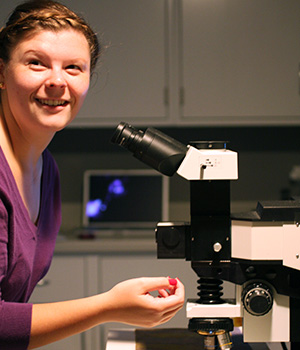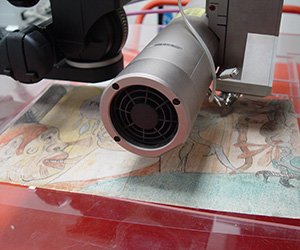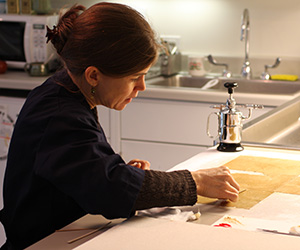McCormick Student’s Detective Work on Display at the Art Institute
Emilie Campbell helped analyze James Ensor’s The Temptation of Saint Anthony
In 1887, Belgian artist James Ensor toiled in his cramped studio above his parents’ house. In obsessive detail he sketched out the bizarre and sometimes grotesque figures that eventually made up his mixed media pièce de résistance, The Temptation of Saint Anthony. Little did he know, 123 years later and 4,330 miles away, his work would fall beneath the microscope of a young American student.
 In 2010, Emilie Campbell spent her summer participating in Northwestern University’s Research Experience for Undergraduates (REU) program, visiting from St. Mary’s College of Maryland. Double-majoring in chemistry and art history, she was a good fit for the laboratory of Katherine Faber, who is now an adjunct professor of materials science and engineering in the McCormick School of Engineering and founding co-director of the Northwestern University/Art Institute of Chicago Center for Scientific Studies in the Arts (NU-ACCESS).
In 2010, Emilie Campbell spent her summer participating in Northwestern University’s Research Experience for Undergraduates (REU) program, visiting from St. Mary’s College of Maryland. Double-majoring in chemistry and art history, she was a good fit for the laboratory of Katherine Faber, who is now an adjunct professor of materials science and engineering in the McCormick School of Engineering and founding co-director of the Northwestern University/Art Institute of Chicago Center for Scientific Studies in the Arts (NU-ACCESS).
Four years prior, the Art Institute of Chicago had purchased Ensor’s monumental art piece. When the complex drawing—standing at 6 feet tall and just over 5 feet wide—arrived from Europe, it was in desperate need of extensive conservation. On May 27, 1940, a bomb blast during the Battle of Belgium hit near Ensor’s studio and air displacement caused large areas of loss in the paper. In addition, degradation of the paper due to light exposure and the ambient environment developed over time both while in the artist’s attic studio and in the homes of subsequent owners.
“After that, the piece was repaired by professional restorers,” said Campbell, who is now a PhD student in McCormick’s Department of Materials Science and Engineering. “The Art Institute wanted to identify which pieces were the actual artist’s and which pieces were by the hands of the restorers. That’s where I came in.”
 Art scholars often say The Temptation of Saint Anthony is Ensor’s most important work on paper. It depicts Jesus hovering above a kneeling St. Anthony, whose eyes are clenched tightly in prayer. Densely filling the area around them are demons, seductresses, and other macabre figures that vie for Anthony’s attention. Remarkable in size and in the number of materials Ensor used, which included colored pencils, graphite, charcoal, gouache, watercolor, and more, the piece comprises 51 individual sheets torn from Ensor’s sketchbook and affixed together.
Art scholars often say The Temptation of Saint Anthony is Ensor’s most important work on paper. It depicts Jesus hovering above a kneeling St. Anthony, whose eyes are clenched tightly in prayer. Densely filling the area around them are demons, seductresses, and other macabre figures that vie for Anthony’s attention. Remarkable in size and in the number of materials Ensor used, which included colored pencils, graphite, charcoal, gouache, watercolor, and more, the piece comprises 51 individual sheets torn from Ensor’s sketchbook and affixed together.
Faber sent Campbell to work with collaborators Francesca Casadio, the A.W. Mellon Senior Conservation Scientist and founding co-director of NU-ACCESS, and Kimberly Nichols, associate paper conservator, at the Art Institute of Chicago. They challenged her to analyze and document the artwork’s pigments. The towering drawing had been disassembled for easier examination and conservation. Campbell performed X-ray fluorescence and infrared analysis as well as Raman and scanning electron microscopy to determine the myriad types of colored materials used and whether a timeline of application could be established.
“I analyzed the pigments, which were then compared to pigments that would have been available at the time Ensor was working,” Campbell said. “If we found pigments that wouldn’t have been available at his time or in his region, then we knew it was the work of a later restorer.”
 Although no anachronistic pigments were found, the careful observation of historical photographs and of the work of art allowed Nichols to precisely identify the areas of restoration.
Although no anachronistic pigments were found, the careful observation of historical photographs and of the work of art allowed Nichols to precisely identify the areas of restoration.
After Campbell left the REU program and returned to Maryland, the piece underwent three more years of analysis and paper conservation. Now it is exhibited as a part of Temptation: The Demons of James Ensor at the Art Institute of Chicago until Sunday, January 25.
Hosted by the Materials Research Science and Engineering Center, the summer REU program allows students to contribute to a research project led by a center faculty member, which expands their science and engineering experience into a range of fields.
“My REU experience is the entire reason I came to Northwestern for graduate school,” Campbell said. “It was the first experience I had with graduate research and the reason I decided to get my PhD.”